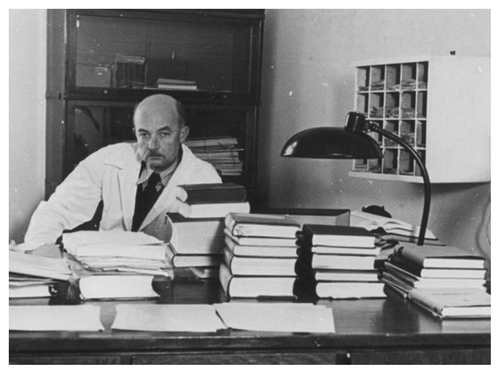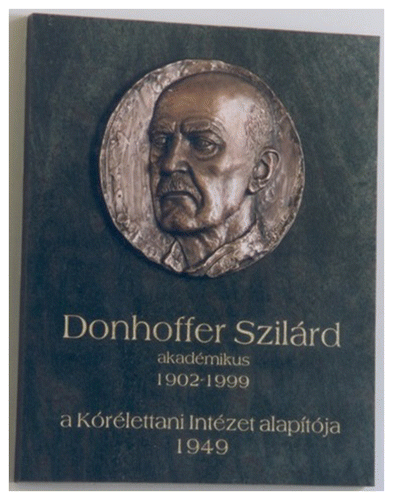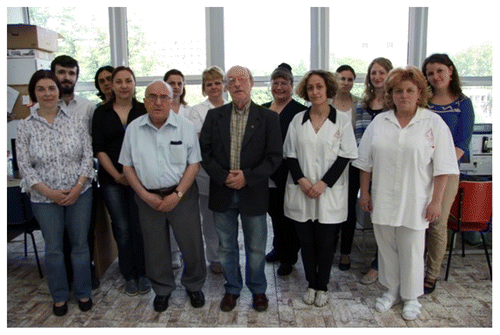Abstract
The authors summarize the main events in the long life of Szilárd Donhoffer and his importance in founding thermoregulatory research at Pécs, Hungary.
We, two pupils and disciples of Professor Szilárd Donhoffer, wish hereby to recognize and honor his transcendent contributions to experimental physiology and pathophysiology in general, and to thermoregulatory research in particular. Prof. Donhoffer’s manifold achievements in research were based on a strong premedical and medical education, more than two decades in clinical practice and a very productive period conducting laboratory work abroad. His almost full one century-long life can be divided into four quarter-century periods: the first spent on his formal education, the second engaged in medical practice, the third committed to the founding and development of the Department of Pathophysiology in Pécs, and the last dedicated to mentoring his successors in the Department in their efforts to extend and carry forward his scientific legacy.
Szilárd Donhoffer was born in 1902 in Budapest to a traditional, well-to-do, intellectual family. His early education included acquiring, in addition to a firm knowledge of the natural sciences, a high level of proficiency in foreign languages (particularly German and English) that later served him well in his readings of the foreign literature and communications with colleagues at international congresses. After graduating in general medicine at the Péter Pázmány University in Budapest in 1926, the young Dr. Donhoffer was invited to a junior clerkship in a hospital in Pécs, a part of the then recently re-established University of Pécs one of the oldest in Europe having been founded in 1367. Two years later, he was sent to Aberdeen, Scotland, where he worked under the guidance of Nobel laureate Professor John MacLeod. His one-year’s studies there on the regulation of carbohydrate metabolism resulted in a significant three-part publication that appeared in the Proceedings of the Royal Society.Citation1
His period as a clinician was very active. He not only headed a ward, but also authored several clinical reports that were published in German or English as well as an excellent book on medical diagnostics in Hungarian that remained very popular with medical students and young doctors alike for several decades. All this expertise eventually contributed to his instituting a new discipline in the medical curriculum, Pathophysiology. Consequently, he was chosen by the Senate of the University of Pécs to inaugurate a department by this name shortly after the end of the Second Word War. Similar departments were subsequently established throughout the country, in Budapest, Szeged and Debrecen, the sites of the other medical schools in Hungary.
To organize a new department at that time was a very difficult undertaking indeed, for several reasons: first, young, enthusiastic doctors with the requisite training to conduct research were scarce; second, suitable premises and equipment were in short supply; and third, good quality textbooks in a field just emerging were nonexistent. In the undergraduate medical curriculum, Pathophysiology was meant to bridge the gap between the basic science fields of Physics, Chemistry, Anatomy, and Physiology and the clinical subjects of Medicine and Surgery (). In addition to promoting the essential technical and personal environment to undertake experimental work, Donhoffer also devoted much energy to composing an extensive, one-authored Textbook of Pathophysiology in the Hungarian language. Its first edition appeared in 1957. This imposing 800-pages book was intimidating even to the most talented students because of its rich factual content and the logical manner in which the author developed each subject such that the deductions from the data became inescapable. Indeed, this textbook continued for several decades to be a useful and popular reference not only for medical students, but also for young doctors preparing for specialist’s exams. His lectures were similarly characterized by very logical expositions on the topic in question, such that the audience could easily follow his development of a particular concept. He usually presented several plausible solutions to the problem under discussion, rejected these one by one until, at the end, there was only one possible, valid explanation. This style of lecturing demanded extreme attention on the part of the students. In fact, he may have been reaching only the top 10 percent of all present.
Thanks to the progressive improvement in the technical environment for experimental work, and the expert guidance of Professor Donhoffer, the Department produced an increasing number of original research papers that appeared in Hungarian as well as in international journals. Initially, he directed the Department’s studies to the energetic aspects of nutrition, a field that required only relatively modest material support.Citation2 But later, he successfully combined this area with another field of energetics: thermoregulation. In one of the papers characteristic of his keen reasoning, he suggested that two conditions that individually are deleterious, protein deficiency and cold exposure, may contribute to increased survival in rats when applied simultaneously.Citation3,Citation4 From the late 60s onward, thermoregulation was the prevalent research field in the Department. Under Professor Donhoffer’s continued guidance, the direction of the studies in the Department evolved over time and attracted increasing numbers of young doctors to join in the research. He thus stimulated new investigations on the role of brown adipose tissue in various aspects of thermoregulationCitation5,Citation6 and prepared his students for their later studies on other aspects of thermoregulation, such as fever, hyperthermia and, with advancing knowledge on the identity of regulatory peptides, on the complex interplay among different aspects of animal energetics, such as heat production, food intake and physical activity. Another subject matter in which Professor Donhoffer was very interested concerned the possible role of cerebral tissues in thermoregulatory heat production. In particular, evidence for this role came from studies performed in rat and rabbit experiments utilizing methods thought to give information on cerebral blood flow and oxygen utilization by measuring changes of intracerebral impedance and polarography, respectively. He eventually described these results in detail in a monographCitation7 and summarized previously in a Hungarian journal publishing in English.Citation8 Professor Donhoffer continued to publish scientific papers well into his 80s.Citation9 In addition to this, he wrote several papers on some theoretical aspects of thermoregulation also in Hungarian.
In addition to his activities as a university teacher, scientist and the founding chair of a new department, Professor Donhoffer served as Pro-rector and then as Rector of the Medical University of Pécs (since 2000, called Medical School at the University of Pécs). In addition, he was elected corresponding member and later ordinary member of the Hungarian Academy of Sciences (). He also served as the President of the medical section of the Academy for one term. Pursuant to his achievements in the field of thermoregulation and his reputation as a discussant on various topics of physiology and pathophysiology, our Department was invited to organize the Satellite Symposium on Thermal Physiology at Pécs as part of the IUPS Congress held in Budapest in 1980. Also noteworthy is the fact that from the early 70s onward, Professor Donhoffer put great emphasis on sending all his young coworkers to spend at least one year each in different European and overseas countries (England, Ireland, Switzerland, Germany, Canada, and USA) to conduct research, this at a time when getting permission to cross the Western border was very difficult indeed. This became possible in the largest measure thanks only to his prestige at his home university and in academic circles world-wide ().
Figure 2. Four professors (also members of the Hungarian Academy of Sciences) at a reception at the University of Pécs in 1980 (L-R, Jenő Ernst, Béla Flerkó, Szilárd Donhoffer, János Szentágothai).

Figure 3. Donhoffer (90 y-old) receiving the Medal of the Hungarian Physiological Society from its president, Emil Monos.
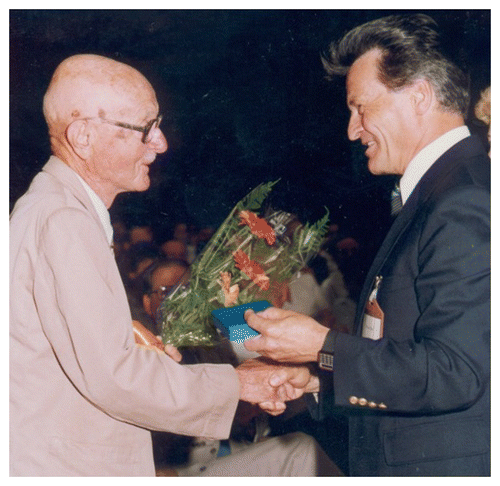
After his retirement in 1974, he continued to be active not only in the Department and the University, but also within the Hungarian scientific community, serving as a valued and esteemed advisor to young and old colleagues alike; many of whom regularly visited him (). Three days before his death, he was at his desk as usual in his small office in the Department when he suddenly felt extreme weakness and phoned the Rector to inform him that he should not count on him anymore. He died in 1999, close to his 97th birthday (). He was survived by two daughters, both medical doctors, and seven grandchildren. His ashes were laid in Budapest in the patheon of the Hungarian Academy of Sciences, together with his wife’s who died a couple of years earlier. In living testimony to his scientific achievements, the Thermoregulatory Group of the Department is continuing to study various aspects of energetics, a scientific field still attracting PhD students and postdocs to the laboratory ().
Figure 4. Donhoffer talking to one of his colleagues after receiving the Honoris Causa Medal at the University of Pécs in 1996.
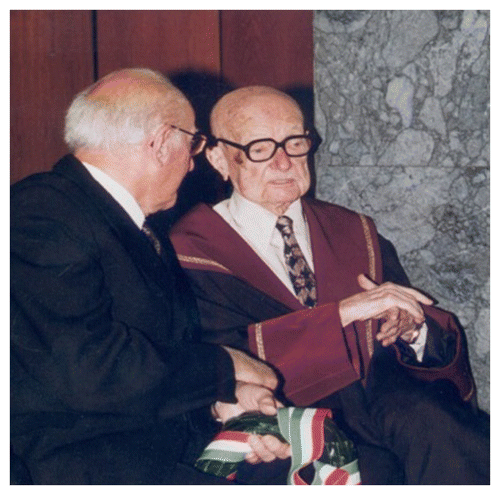
Disclosure of Potential Conflicts of Interest
No potential conflicts of interest were disclosed.
References
- Donhoffer C, MacLeod JJR. Studies in the nervous control of carbohydrate metabolism. Proc R Soc Lond, B 1932; 110:125 - 71; http://dx.doi.org/10.1098/rspb.1932.0016
- Donhoffer S, Vönötzky J. The effect of thyroxine on food intake and selection. Am J Physiol 1947; 150:334 - 9; PMID: 20258392
- Andik I, Donhoffer S, Farkas M, Schmidt P. Ambient temperature and survival on a protein-deficient diet. Br J Nutr 1963; 17:257 - 61; http://dx.doi.org/10.1079/BJN19630028; PMID: 14012939
- Székely M, Romanovsky AA. Szilárd Donhoffer: Mastermind of the study demonstrating how cold prevented death of protein deficiency. Temperature 2014; Forthcoming http://dx.doi.org/10.4161/temp.29006
- Donhoffer S, Szelényi Z. The role of brown adipose tissue in thermoregulatory heat production in the non cold-adapted adult rat, guinea pig, ground squirrel and in the young rabbit. Acta Physiol Acad Sci Hung 1965; 28:349 - 61; PMID: 5859487
- Székely M, Kellermayer M. Donhoffer Sz. Thermoregulatory role of periaortic brown adipose tissue in rats acclimated to different ambient temperatures. Acta Physiol Hung 1971; 40:251 - 60
- Sz D. Homeothermia of the brain. Budapest: Akadémiai Kiadó, 1980.
- Szelényi Z. Donhoffer Sz. The effect of cold exposure on cerebral blood flow and available oxygen (aO2) in the rat and rabbit: Thermoregulatory heat production by the brain and the possible rile of neuroglia. Acta Physiol Hung 1978; 52:391 - 402
- Donhoffer S. Body size and metabolic rate: exponent and coefficient of the allometric equation. The role of units. J Theor Biol 1986; 119:125 - 37; http://dx.doi.org/10.1016/S0022-5193(86)80068-6; PMID: 3736070

